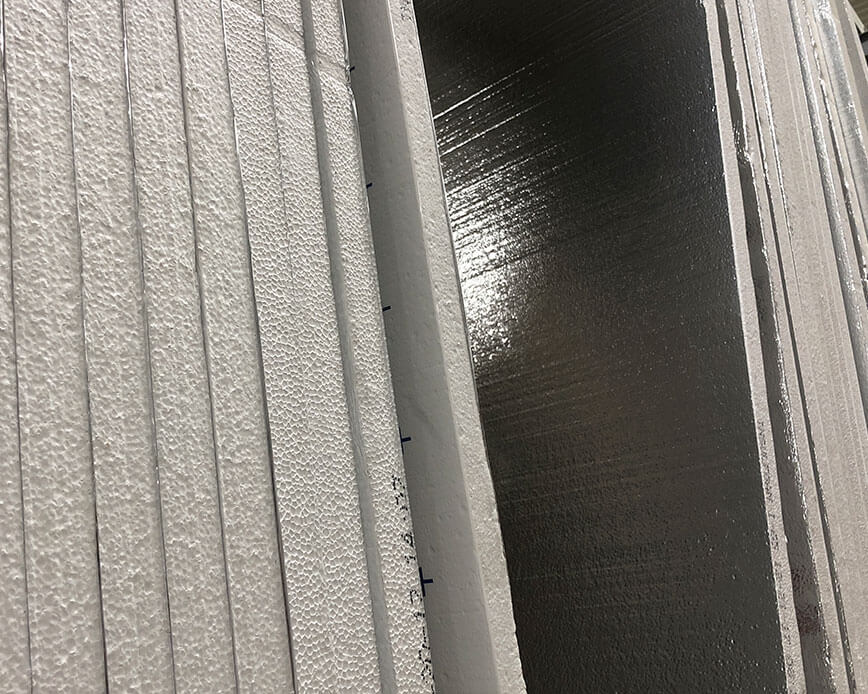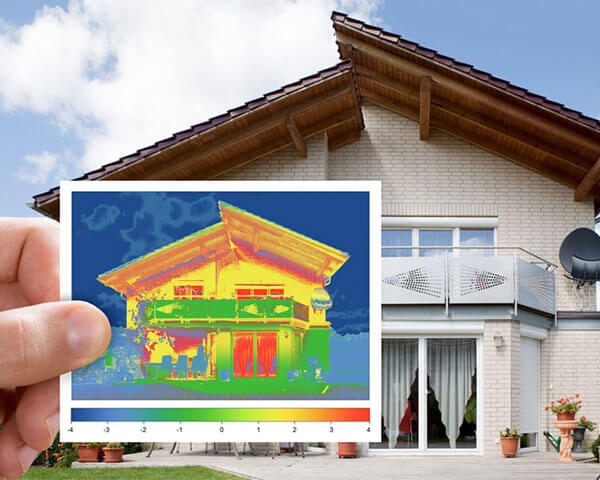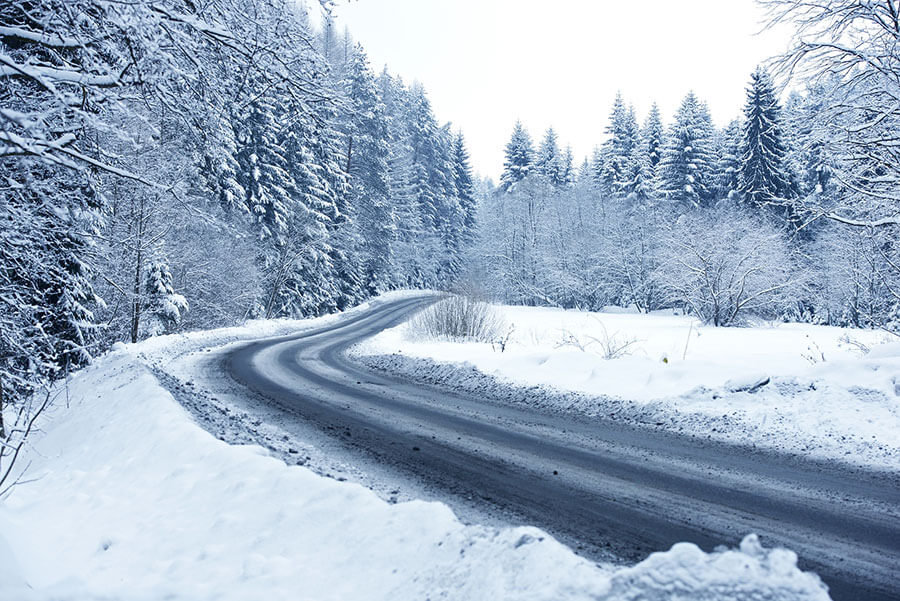We’re seeing a material shift, literally. There’s a sweeping wave of synthetic, fabricated materials being used more frequently in construction, and this is a paradigm shift in construction. Leading the pack are changes in how we insulate.
Read on to learn more about the pros and cons of Rigid Foam Sheathing in high-performance building.
Rigid Foam as an Insulation Strategy
Rigid foam sheathing is a form of insulation — continuous insulation, to be exact — that’s applied to the exterior of the building. Continuous rigid insulation is a construction solution that provides a thermally efficient building enclosure. Rigid insulation sheathing is made of a rigid plastic foam that is typically sold in 4×8- or 4×10-footboards. The boards are available in several thicknesses and R-values; 1-inch and 2-inch thicknesses are common. Rigid insulation provides thermal protection and it can also serve as an air and moisture barrier.
There are three primary types of rigid insulation: expanded polystyrene (EPS), extruded polystyrene (XPS), and polyisocyanurate (polyiso). EPS and XPS are thermoplastics, which are non-cross-linked polymers so they are susceptible to deterioration in high temperatures (BSC 2007). Polyiso is a thermoset, which is made up of cross-linked polymers so it has a much higher melting temperature. While properties can vary among specific products, XPS and polyiso tend to be higher density, higher R-value, and lower permeance than EPS.
When rigid foam insulating sheathing is installed on the exterior walls of a home, the foam can serve as a drainage plane, taking the place of house wrap for time and cost savings. To serve as a drainage plane, the seams in the foam sheathing must be properly taped with sheathing and flashing tapes to provide continuity of the drainage plane at joints between panels. The tapes must be durable enough to prevent ingress of water at panel joints for the life of the system. Sheathing tapes and sometimes flashing tapes are also needed to integrate the top edge of diversion flashings (head flashings, flashings over penetrations, step flashings, kick-out flashings, etc.) with the drainage plane.
Rigid Foam and Building Codes
Because of its thermal properties, rigid insulation is being called for by certain codes and programs. ENERGY STAR(TM) requires that rigid foam or insulated siding be installed over walls if they are metal framed (ENERGY STAR 2015). ENERGY STAR also requires that rigid foam sheathing or insulated siding or a combination of the two be installed to a thickness of ≥R-3 in Climate Zones 1 to 4 or ≥R-5 in Climate Zones 5 to 8 (ENERGY STAR 2015).
Continuous rigid insulation also provides an effective solution to thermal bridging. Thermal bridging occurs wherever assembly components with low R-values (such as wood or steel) span from the interior to the exterior of the building. In traditional building construction, while the wall cavities are filled with insulation, there is no insulation at the window frames, door frames, studs, top plates and bottom plates; together this framing comprises nearly one-fourth of the wall area. Rigid insulation can be attached to the exterior side of the framing to provide a continuous insulating layer that reduces thermal losses through thermal bridging.
3 Benefits of Rigid Foam Sheathing
More effective insulation
With R-values ranging from 3.6 to 8.0, rigid foam sheathing has much better insulation per inch than other materials (i.e. plywood has an R-value of 1.25 and fiberglass batts have an R-value of 3.14). This is especially critical in preventing damage (such as mold and rot) to framing and walls in areas with extremely cold or damp climates. Since rigid foam is applied on the outside it also prevents thermal bridging. Thermal bridging happens when there is a loss of heat due to an interruption in the insulation by a material that is more conductive. This typically happens when interior insulation intersects things like stud frames or electrical boxes.
Better at controlling moisture When it comes to controlling moisture, rigid foam serves two functions. It protects the wood sheathing or framing from any rain or water that leaks in under the siding. And it warms the interior sheathing or framing enough to prevent moisture accumulation from the heated interior air in the winter.
Better at preventing air leaks
When sealed with proper techniques and a suitable adhesive, rigid foam is an excellent air barrier. The same principle mentioned above that prevents thermal bridging also applies to air transfer. Unlike house wrap, which works to prevent infiltration (air coming into the building) but is poor at stopping exfiltration (air moving out of the building), rigid foam is able to do both.
Disadvantages of Rigid Foam
Must be installed properly to limit air leaks and act as a weather-resistive barrier
Rigid foam does not require specialized equipment to install it but you do need to follow strict seam-sealing procedures to meet code.
Less structural strength than plywood or OSB sheathing
If rigid foam sheathing is used on top of wood sheathing, this doesn’t matter. However, if you want to use rigid foam in place of wood sheathing it needs additional bracing to prevent racking.
Slightly more expensive
Adding a layer of rigid foam on top of plywood or OSB sheathing will increase the cost of the project. However, this is just a short-term, fixed cost. Rigid foam often pays for itself with lower utility bills over the long term. And it may put off or prevent costly work to repair rot in walls or framing.
Installing Rigid Foam Sheathing
When using foam insulation, you’ll need to decide whether you intend to use OSB in addition to the rigid foam to serve as the building sheathing or if the rigid foam layer will itself serve as the sheathing, and you’ll need to determine what will serve as the drainage plane and where this layer will be. These decisions are determined somewhat by climate.
- Extruded polystyrene (XPS) and foil-faced polyisocyanurate (polyiso) are high-density rigid-foam insulations that can be used as exterior insulation and are generally approved, per Building America(SM) to be used as a drainage plane if the joints are sealed.
- Insulation sheathing membranes rely on tape to complete the air barrier; the tapes should be applied on a clean, dry, warm surface.
- For the rigid insulation to be used as a water-resistive barrier, the vertical plane of the exterior face of the sheathing must be as smooth and continuous as possible.
The lowest cost, highest performing rainwater management strategy is rigid polymeric foam sheathing with sealed joints (Lstiburek 2006, 2010). There is an existing construction challenge of sealing the joints in rigid polymeric foam sheathing in a reliable and durable manner to prevent water ingress.
Best Practices for Taping Rigid Foam Sheathing
The Building America Solution Center has the following builder guidelines for taping rigid foam:
- When rigid foam is used as the weather-resistive barrier and/or the air barrier, tape all seams using manufacturer-recommended tape per the manufacturer’s instructions. Wipe the surface of the foam with a clean dry cloth before taping to ensure good adhesion by removing dirt or oil residue which is common on foil-faced polyiso.
- When rigid foam is used as the weather-resistive barrier, apply flashing shingle fashion around all openings for doors, windows, etc., to reduce bulk moisture intrusion and air infiltration.
- Center the tape over the joint to cover the fasteners. Fasteners located in the center areas of the boards do not need to be taped. Use a shingle fashion technique when taping joints. Avoid taping during extremes in temperature; install tape per the manufacturer’s instructions, which is generally between 15°F and 120°F.
- Apply pressure along the entire surface for a good bond. Remove all wrinkles and bubbles by smoothing the surface and, if necessary, repositioning.
When working with any new material, you have to make sure you have enough available surface contact. We’re seeing applications where tape works well with synthetics, but we’re also seeing materials that offer a very imperfect surface to bond to. As new materials are introduced, and airtightness remains a critical requirement, the industry needs a pressure-sensitive tape that’s going to bond quickly to rigid insulation and stay that way.
Which is exactly why ECHOtape launched our new, next generation seaming tape. PE-M4535 is a proprietary high-performance building tape, made from an advanced polyester backing, which makes it extremely strong and easy to apply. Available in red, silver and white, it is a versatile product used in a wide variety of building envelope sealing applications, including cold weather applications. As excited as we are about PE-M4525, ECHOtape R&D team is continuing to develop additional seaming products to meet the needs of a rapidly changing building industry, products that will adhere to a wide range of building materials and surfaces including house wrap, exterior, and rigid insulation, sheathing, vapor barriers and a variety of underlayments.
Do you have a specific need or seaming challenge? Tell us about it! We love to solve tape challenges.




